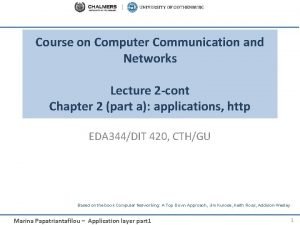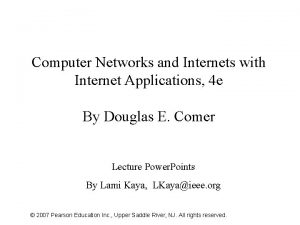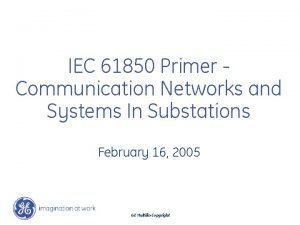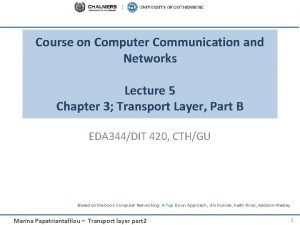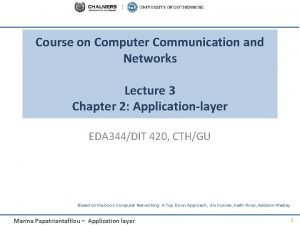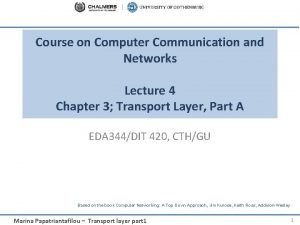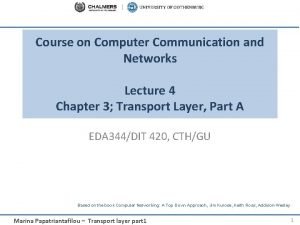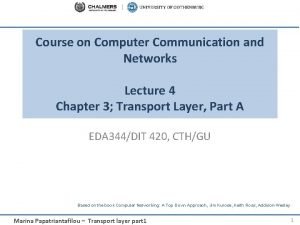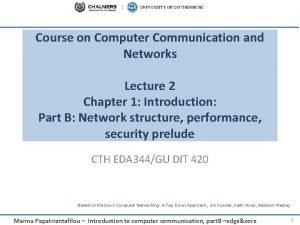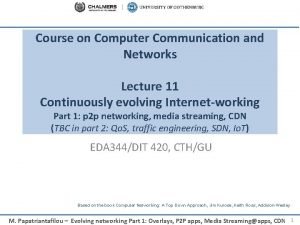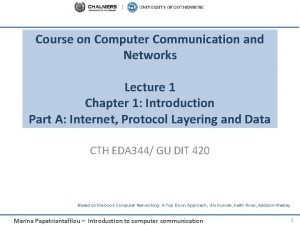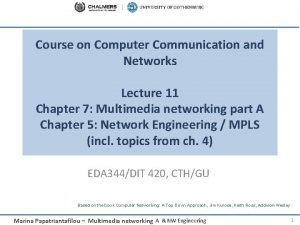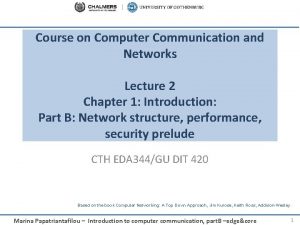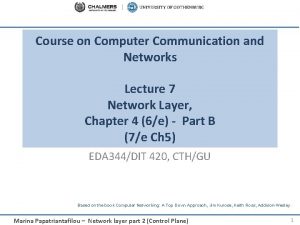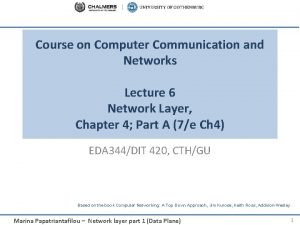Course on Computer Communication and Networks Lecture 14






























- Slides: 30

Course on Computer Communication and Networks Lecture 14 part. B Chapter 2. 6; peer-to-peer applications (and network overlays) EDA 344/DIT 420, CTH/GU Based on the book Computer Networking: A Top Down Approach, Jim Kurose, Keith Ross, Addison-Wesley. Marina Papatriantafilou – Overlays and peer-to-peer applications 1

Network overlays Overlay: a network implemented on top of a network Why? What to do with this? Recall: applications can deal with needs of multimedia traffic They actually do more for sharing resources @ edge of the network with peer-to-peer (P 2 P) overlays Marina Papatriantafilou – Overlays and peer-to-peer applications

Pure P 2 P architecture • no always-on server • arbitrary end systems directly communicate • peers are intermittently connected and change IP addresses examples: – file distribution/sharing (Bit. Torrent, …) – Streaming (Kan. Kan) – Vo. IP (Skype) Application Layer Marina Papatriantafilou – Overlays and peer-to-peer applications 2 -3

file-sharing peer-to-peer (p 2 p) applications: preliminaries Background: Common Primitives in file-sharing p 2 p apps: • Join: how do I begin participating? • Publish: how do I advertise my file? • Search: how to I find a file/service? • Fetch: how to I retrieve a file/use service? Marina Papatriantafilou – Overlays and peer-to-peer applications 4

Roadmap First generation in p 2 p: file sharing/lookup • Centralized Database: single directory – Napster • Query Flooding – Gnutella • Hierarchical Query Flooding – Ka. Za. A • Structured Overlays – DHT Second generation in p 2 p …. Marina Papatriantafilou – Overlays and peer-to-peer applications 3 a-5

P 2 P: centralized directory File transfer: HTTP original “Napster” design (1999, S. Fanning) 1) when peer connects, it informs central server: Bob centralized directory server 1 peers – IP address, content 2) Alice queries directory server for “Boulevard of Broken Dreams” 3) Alice requests file from Bob 1 3 1 2 Q: What is p 2 p in this? Marina Papatriantafilou – Overlays and peer-to-peer applications 1 Alice 6

Roadmap First generation in p 2 p: file sharing/lookup • Centralized Database: single directory – Napster • Query Flooding – Gnutella • Hierarchical Query Flooding – Ka. Za. A • Structured Overlays – DHT Second generation in p 2 p …. Marina Papatriantafilou – Overlays and peer-to-peer applications 3 a-7

Gnutella: protocol Query Flooding: • Join: on startup, client connects to a few other nodes (learn from bootstrap -node); these become its “neighbors” (overlay!! ) File transfer: HTTP Query. Hit • Publish: no need • Search: ask “neighbors”, who ask their neighbors, and so on. . . when/if found, reply to sender. • Fetch: get the file directly from peer y er u Q ry e Qu t i H Query. Hit Qu Qu ery er y Marina Papatriantafilou – Overlays and peer-to-peer applications 8

Gnutella: Search I have file A. Reply Request/Fetch Query Where is file A? Q: Compare with Napster Marina Papatriantafilou – Overlays and peer-to-peer applications 9

Discussion +, -? Napster § Pros: § § Simple Search scope is O(1) § Cons: § § § Server maintains O(peers, items) State Server performance bottleneck Single point of failure Gnutella: • Pros: – Simple – Fully de-centralized – Search cost distributed • Cons: – Search scope is O(peers, items) – Search time is O(? ? ? ) Marina Papatriantafilou – Overlays and peer-to-peer applications 10

Synch questions: how are the ”neighbors” connected? what is the overlay here useful for? – Edge is not a physical link E. g. edge between peer X and Y if they know each-other’s IP addresses or there’s a TCP connection – Used for supporting the search operation (aka routing in p 2 p networks) Marina Papatriantafilou – Overlays and peer-to-peer applications 11

Roadmap First generation in p 2 p: file sharing/lookup • Centralized Database: single directory – Napster • Query Flooding – Gnutella • Hierarchical Query Flooding : some directory structure – Ka. Za. A • Structured Overlays – DHT Second generation in p 2 p …. Marina Papatriantafilou – Overlays and peer-to-peer applications 3 a-12

Ka. Za. A: join, publish “Smart” Query Flooding: • Join: on startup, client contacts a “supernode”. . . may at some point become one itself • Publish: send list of files to supernode “Super Nodes” insert(X, 123. 2. 21. 23). . . Publish I have X! 123. 2. 21. 23 Marina Papatriantafilou – Overlays and peer-to-peer applications 13

Ka. Za. A: Search search(A) --> 123. 2. 22. 50 “Smart” Query Flooding: • Search: send query to supernode, supernodes flood query amongst themselves. • Fetch: get the file directly from peer(s); can fetch simultaneously from multiple peers “Super Nodes” 123. 2. 22. 50 Query Replies search(A) --> 123. 2. 0. 18 Where is file A? 123. 2. 0. 18 Q: Compare with Napster, Gnutella (publishing, searching, anything else) Marina Papatriantafilou – Overlays and peer-to-peer applications 14

Ka. Za. A: Discussion • Pros: – Tries to balance between search overhead and space needs (trading-off Napster’s & Gnutella’s extremes) – Tries to take into account node heterogeneity: • Peer’s Resources (eg bandwidth) • Cons: – No real guarantees on search scope or search time – Super-peers may “serve” a lot! • P 2 P architecture used by Skype, Joost (communication, video distribution p 2 p systems) Marina Papatriantafilou – Overlays and peer-to-peer applications 15

Roadmap First generation in p 2 p: file sharing/lookup • Centralized Database: single directory – Napster • Query Flooding – Gnutella • Hierarchical Query Flooding – Ka. Za. A • Structured Overlays – Combine database+distributed system know-how Second generation in p 2 p …. Marina Papatriantafilou – Overlays and peer-to-peer applications 3 a-16

Problem from this perspective How to find data in a distributed file sharing system? (aka “routing” to the data, i. e. content-oriented routing) Publisher Key=“Let. It. Be” Value=MP 3 data N 2 N 1 N 3 Internet N 4 N 5 Client ? Lookup(“Let. It. Be”) How to do Lookup? Marina Papatriantafilou – Overlays and peer-to-peer applications 17

Centralized Solution Central server (Napster) Publisher Key=“Let. It. Be” Value=MP 3 data N 2 N 1 N 3 Internet DB N 4 N 5 Client Lookup(“Let. It. Be”) O(peers, items) state at server, O(1) at client O(1) search communication overhead Single point of failure Marina Papatriantafilou – Overlays and peer-to-peer applications 18

Distributed Solution Flooding (Gnutella, etc. ) Publisher Key=“Let. It. Be” Value=MP 3 data N 2 N 1 N 3 Internet N 4 N 5 Client Lookup(“Let. It. Be”) O(1) state per node Worst case O(peers, items) complexity per lookup Marina Papatriantafilou – Overlays and peer-to-peer applications 19

Distributed Solution (with some more structure? In-between the two? ) Publisher balance the update/lookup complexity. . Key=“Let. It. Be” Abstraction: a lookup data structure Value=MP 3 data. N 2 (distributed “hash-table” DHT) : N 1 N 3 insert(key, item); item = get(key); Internet N 4 N 5 Client Lookup(“Let. It. Be”) Marina Papatriantafilou – Overlays and peer-to-peer applications 20

(Recalling hash tables) figure source: wikipedia; "Hash table 3 1 1 0 0 SP" by Jorge Stolfi - Own work. Licensed under CC BY-SA 3. 0 via Commons - https: //commons. wikimedia. org/wiki/File: Hash_table_3_1_1_0_0_SP. svg#/media/File: Hash_table_3_1_1_0_0_SP. svg Marina Papatriantafilou – Overlays and peer-to-peer applications

Distributed Hash Tables (DHT) Implementation: • nodes form an overlay (a distributed data structure) eg. Ring, Tree, cube • Hash function maps entries to nodes (insert) • Nodes-overlay has structure (Distributed Hash Table); using it, do: • Upon being queried: ”I do not know DFCD 3454 but can ask some Neighbour/s in the DHT” Lookup/search: find the node responsible for item; that one knows where the item is figure source: wikipedia Marina Papatriantafilou – Overlays and peer-to-peer applications 22

e. g. Circular DHT (1) O(N) messages on avgerage to resolve query, when there are N peers I am 0001 Who’s responsible for key 1110 ? 0011 1110 0100 1110 1100 1110 0101 1110 1000 Marina Papatriantafilou – Overlays and peer-to-peer applications 24

Circular DHT with shortcuts 1 3 Who’s responsible for key 1110? 15 4 12 5 10 8 • Here: reduced from 6 to 2 messages. • possible to design shortcuts so O(log N) neighbors, O(log N) messages in query Marina Papatriantafilou – Overlays and peer-to-peer applications Application 2 -25

Roadmap First generation in p 2 p: file sharing/lookup • Centralized Database: single directory – Napster • Query Flooding – Gnutella • Hierarchical Query Flooding – Ka. Za. A • Structured Overlays – DHT Second generation in p 2 p …. • Swarming – Bit. Torrent, Avalanche, … Marina Papatriantafilou – Overlays and peer-to-peer applications 3 a-26

Bit. Torrent: Next generation fetching • Key Motivation: – Popularity exhibits temporal locality (Flash Crowds) – Can bring file “provider” to “its knees” • Idea: Focused on Efficient Fetching, not Searching: – Files are “chopped” in chunks, fetching is done from many sources – Overlay: nodes “hold hands” with those who share (send chunks) at similar rates • Method used by publishers to distribute software, other large files • http: //vimeo. com/15228767 Marina Papatriantafilou – Overlays and peer-to-peer applications 27

Bit. Torrent: Overview Swarming: • Join: contact some server, aka “tracker” get a list of peers. • Publish: can run a tracker server. • Search: Out-of-band. E. g. , use search-engine, some DHT, etc to find a tracker for the file you want. Get list of peers to contact for assembling the file in chunks • Fetch: Download chunks of the file from several of your peers. Upload chunks you have to them. tracker: tracks peers participating in torrent: group of peers exchanging chunks of a file obtain list of peers trading chunks peer Marina Papatriantafilou – Overlays and peer-to-peer applications 28

File distribution: Bit. Torrent • tracker: tracks peers participating in torrent: group of peers exchanging chunks of a file • • obtain list of peers trading chunks Peer joining torrent: – has no chunks, but will accumulate over time – gets list of peers from tracker, connects to subset of peers (“neighbors”) who share at similar rates (tit-fortat) while downloading, peer uploads chunks to other peers. once peer has entire file, it may (selfishly) leave or (altruistically) remain peer Marina Papatriantafilou – Overlays and peer-to-peer applications 29

Roadmap First generation in p 2 p: file sharing/lookup • Centralized Database: single directory – Napster • Query Flooding – Gnutella • Hierarchical Query Flooding – Ka. Za. A • Structured Overlays – DHT Second generation in p 2 p …. • Swarming Marina Papatriantafilou – Overlays and peer-to-peer applications 3 a-30

Reading instructions • Kurose. Ross book: chapter 2. 6 for Further Study, optional • • • Aberer’s coursenotes and references therein – http: //lsirwww. epfl. ch/courses/dis/2007 ws/lecture/week%208%20 P 2 P%20 systems-general. pdf – http: //lsirwww. epfl. ch/courses/dis/2007 ws/lecture/week%209%20 Structured%20 Overlay%20 Networks. p df Regarding fair sharing in p 2 p systems – Incentives build Robustness in Bit. Torrent, Bram Cohen. Workshop on Economics of Peer-to-Peer Systems, 2003. – Do incentives build robustness in Bit. Torrent? Michael Piatek, Tomas Isdal, Thomas Anderson, Arvind Krishnamurthy and Arun Venkataramani, NSDI 2007 Regarding other applications in p 2 p sharing, eg Dissemination and media streaming – J. Mundinger, R. R. Weber and G. Weiss. Optimal Scheduling of Peer-to-Peer File Dissemination. Journal of Scheduling, Volume 11, Issue 2, 2008. [ar. Xiv] [Jo. S] – Christos Gkantsidis and Pablo Rodriguez, Network Coding for Large Scale Content Distribution, in IEEE INFOCOM, March 2005 (Avalanche swarming: combining p 2 p + media streaming) Pointers to some work by the group • Georgiadis, G. ; Papatriantafilou, M. : Overlays with preferences: Approximation algorithms for matching with preference lists. IEEE IPDPS 2010 • Zhang Fu, Marina Papatriantafilou: Off the Wall: Lightweight Distributed Filtering to Mitigate Distributed Denial of Service Attacks. SRDS 2012: 207 -21 (builds on router-overlays) Marina Papatriantafilou – Overlays and peer-to-peer applications 3 -31
 Virtual circuit and datagram network
Virtual circuit and datagram network Basestore iptv
Basestore iptv 01:640:244 lecture notes - lecture 15: plat, idah, farad
01:640:244 lecture notes - lecture 15: plat, idah, farad Computer communication course
Computer communication course Course title and course number
Course title and course number Integrated and differentiated services in computer networks
Integrated and differentiated services in computer networks Checksum in computer networks with example
Checksum in computer networks with example What is bit and byte stuffing
What is bit and byte stuffing Bit stuffing byte stuffing
Bit stuffing byte stuffing Arp rarp protocol
Arp rarp protocol Analogue and digital transmission in computer networks
Analogue and digital transmission in computer networks Web and http in computer networks
Web and http in computer networks Computer networks and internets with internet applications
Computer networks and internets with internet applications Transmission error in computer networks
Transmission error in computer networks Protocols and standards in computer networks
Protocols and standards in computer networks Crc in computer networks
Crc in computer networks Computer networks and internets
Computer networks and internets Iec 61850 communication networks and systems in substations
Iec 61850 communication networks and systems in substations Game theory in wireless and communication networks
Game theory in wireless and communication networks Networks of communication and exchange
Networks of communication and exchange What is half brick wall
What is half brick wall Chaine parallèle muscle
Chaine parallèle muscle Computer security 161 cryptocurrency lecture
Computer security 161 cryptocurrency lecture Computer aided drug design lecture notes
Computer aided drug design lecture notes Computer architecture notes
Computer architecture notes Isa computer architecture
Isa computer architecture Crisis communications lecture
Crisis communications lecture Business communication lecture slides
Business communication lecture slides Crc in computer networks
Crc in computer networks Crc in computer networks
Crc in computer networks Traffic management in computer networks
Traffic management in computer networks



